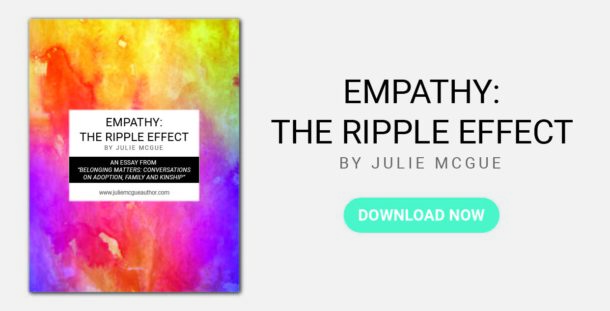How a rural walk provides hope during troubled times

Julie McGue
Author
“After you have exhausted what there is in business, politics, conviviality, love, and so on – have found that none of these finally satisfy, or permanently wear – what remains? Nature remains?” – Mary Shelley
Personal relationships can be difficult to foster in person and are even harder when the people you hold dear are hundreds of miles away. Add a deathly pandemic and potentially dangerous air travel to that mix and maintaining long-distance relationships is uber challenging.
As heartened as I am to have Zoom and Facetime as communication options during these troubled times, I’m equally grateful for the ability to walk outdoors! Walking is how I cope with the many disruptions and inconveniences brought on by the coronavirus. I rely on my daily walk to interrupt the sameness of these socially distanced days, and I’m almost always rewarded with something inspirational from the time spent wandering on foot.
Last week, when I climbed into the red Escort to drive my daughter, Katherine back to her apartment in DC, my walking shoes were at the top of the suitcase. I planned to spend the night in DC with her, get in a good morning walk, and then continue on to New Jersey to visit my other daughter, Margaret and her family. The last time I held my new grandson was Leap Day weekend, two weeks before Covid-19 began ravaging the east coast.
This morning, Jack and I sprawl out on his purple and orange play quilt, and I barricade blocks and books and stuffed animals around the two of us. In yoga pants, sports bra and tee, I’m already dressed for our morning walk, one that is on hold until my daughter slips in from another long night as an OB/GYN resident. The few minutes Margaret can spend with Jack each morning before sleeping and heading back to the hospital are like gold coins. First, Jack and I will play and wait, and then we will walk.
My lower back tightens as I scoop up my exuberant grandson and plop him into my lap for another reading of Good Night Moon.When I cuddle Jack, my chin hovers over his fine, golden hair gifting me with a whiff of last night’s scrub of baby shampoo. The combined nostalgia of the soap’s familiar scent and the baby board book – one which I easily read a thousand times to my own four children – pulls on my heartstrings. I miss those days of mothering, and I resent the pandemic for preventing me from being active in my family’s lives now. As I clear my throat and ready my voice for a moving rendition of Good Night Moon,tires grind on the gravel drive and a car door pops shut.
Before Jack and I can untangle ourselves, Margaret blazes through the back door. She towers above us on the vibrant blanket, smiling and reaching for Jack. Fussing with the toddler, she quizzes me about what kind of night he had and whether I was successful in getting him to eat anything else with his “O’s.” I offer a glowing gramma commentary while evaluating her appearance. Her skin tone is as pale as the morning clouds that stream by, and the bluish-gray tinge below her lower lashes makes it look as if she applied eye shadow in the wrong place. Both are a barometer of how she’s balancing work and family life. The irony of this “mothers mothering” moment is not lost on me. My daughter’s immediate concern is for her child, and mine is on my daughter’s health and well-being.
She dances with the squirming Jack and he giggles with obvious delight at his mother’s entrée into our morning routine. As I gather up the toys and books and stow them in the toybox, the pair stroll cooing and squealing into the adjacent dining room.
Halting in front of the picture window, she jabs a finger at the backyard. “Look, Jack. Mom! Come quick! There’s two deer asleep in the grass.”
Last evening and into the early morning hours, tropical storm Fay ambled through the greater NY/NJ area dumping hail and enough rain to make a swamp of the side yard. The tempest also infused enough moisture into the heat-challenged grass to cause it to glow like a “light chrome green” Crayola.
Five feet apart, noses nuzzling into white underbellies, two fawn lay sleeping in the dewy, lime green grass. Twins! Had it been a day earlier, their fur – the color of gingerbread – might have blended in with the dried-out lawn, and then we would have missed this spectacle.
As if the twin fawns sense an audience, they twitch, stretching legs so long and sinewy that we wonder how it is that they can stand, much less possess the energy to outrun a predator. Star-shaped white spots freckle their light brown skins, telegraphing their age. Like Jack, the fawns are not quite a year. In another few months the white spots will fade, and the fawns will be yearlings. Just like my grandson.
Jack shrieks and the baby deer lift their heads in unison. Telescoping their ears around, the not-quite-yearlings scramble up, play peek-a-boo with us from behind the swing set, and then dart off into the woods. Perhaps, my grandson’s squeal and wild movements spooked the deer, but another possibility is that their mother was feeding nearby and called out to them to join her. From my experience with the herds of deer populating the woods behind my summer house, a doe will deposit her young in a protected place and go off and feed. She is never far away, and she will always return.
It occurs to me that I am like that with my family, in spite of obstacles like restricted air travel and pandemics, and that my daughter is like that with Jack and her husband – her career requires sustained absences, but when she is home her presence is strong and dear.
“Awww. They’re gone, now. Wasn’t that cool, Jack?” Margaret beams at Jack.
She hands Jack to me and rubs her eyes. “Time for my nap.” From the counter, Margaret picks up the baby’s tippee cup and fills it with water. “Have a nice walk, you guys!”
Before buckling Jack into his swanky, all-terrain stroller, I peer into the backyard. No sign of the twin fawns or the doe. As I steer the stroller out of the cul-de-sac, Jack fusses and I get out his tippee cup of cool water. It is when I’m holding the blue cup to Jack’s lips that a memory of an older encounter with a fawn creeps in.
It was another muggy July afternoon, almost exactly two years ago. Katherine was at the wheel of the red Escort. The right tires skidded on the shoulder of Duneland Beach Road where the road bent before the stop sign at Arrowhead. Even though I wasn’t driving, I scanned in both directions, hard.
Much like Margaret had done barely an hour ago, I pointed, and my voice rose with delight. “Look, Katherine. There’s a fawn in the front yard of that house. Stop! I want to get a picture.”
In the few minutes that it took for me to roll down the window and dig for my phone, the fawn had raised itself on wobbly legs, teetering in the grass. From somewhere else in the yard, a doe sauntered into view. As I recall how quickly this scene unfolded, the words I’d uttered earlier to Margaret replay in my head: A mother is never far from its young.
The doe handed the Escort a threatening, unwavering stare. What happened next put Katherine and me in a state of speechless awe. The fawn scampered to the mother’s side and began nursing from her underbelly. Dead center in the neighbor’s front lawn at a fairly busy intersection, the fawn tugged on the doe’s teat, insistently and unabashedly, just as Jack was doing now with his water bottle.
What is remarkable about the timing of this happenstance is that the following day Katherine, a recent college grad, was to board a Southwest flight bound for DC where she would begin her first job. The same job which I returned her to five days ago before venturing up to NJ to see Margaret and her family. Not only was it an unexpected privilege to witness the doe nursing her fawn, the experience was one of the last memories I shared with Katherine before she officially moved out of the house. At that moment, the thoughts in my head had run the gamut: the doe’s with her baby and I’m with mine; she is taking care of her child as I do mine; that offspring is struggling to survive, while mine is starting a new way of life.
Jack drops his blue cup, jiggles his legs and waves his arms at me. He wants to get going, continue our walk.
I smile back at my newest grandson. “Alright then, let’s go Jack. Off to Foote’s Pond. Maybe the heron will be there today. For sure, we’ll see duck leading their ducklings across the pond, and we’ll hear those big old bullfrogs belch. Oh, the things we will see…”
The stroller’s wheels thrum against the pavement drowning out the squeak of my sneakers. Jack quiets and our easy wandering lulls me into constructive thought. I think about my walks this summer, the many encounters with fawn in the grass, motherhood and mothering, and all the threats to relationship and life itself. What seems clear is that life prevails, thrives right smack in front of us. In spite of everything. This realization offers me hope.
Tomorrow, I will return to the summer house and leave my daughter and her family behind. My heart is not heavy. I have learned much from my encounters with the fawn in the grass. Even if the miles that separate us are many, a mother is never far away.
“My daughter’s immediate concern is for her child, and mine is on my daughter’s health and well-being.”

Snag my in-depth reference guide to best equip you for the journey ahead.



0 Comments